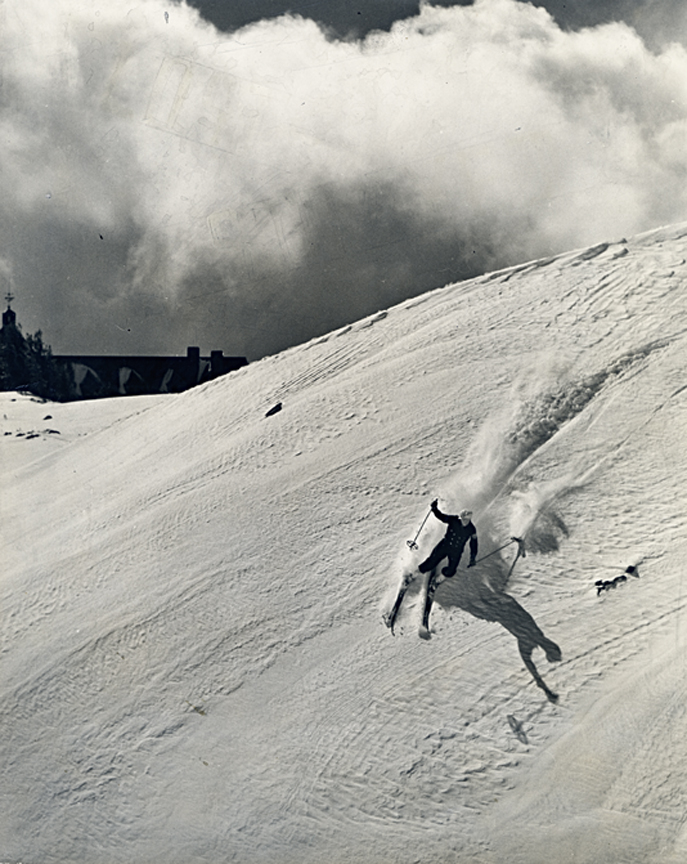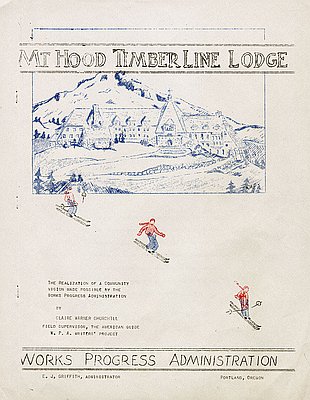- Catalog No. —
- ba018653
- Date —
- November 7, 1938
- Era —
- 1921-1949 (Great Depression and World War II)
- Themes —
- Environment and Natural Resources, Sports and Recreation
- Credits —
- Self-indexing photo file #775-B, Oregon Historical Society Research Library
- Regions —
- Cascades Portland Metropolitan
- Author —
- Ray Atkeson, Oregon Journal/Photo Art
Skier at Timberline Lodge
This photograph appeared in the Oregon Journal under a banner headline announcing the November 6 opening of the 1938 winter skiing season on Mt. Hood. An accompanying article estimated that 2000 skiers participated that day, both at Government Camp and at the recently completed Timberline Lodge. The article noted that parking lots on the mountain contained approximately 600 cars driven by skiing enthusiasts who went to the recreation area for the day.
The earliest skiers in the United States skied primarily as a practical method of transportation. Native Americans had long used snowshoes for transportation in colder climates, but it was the Swedish, Finnish, and Norwegian immigrants who first introduced skis, which proved to be useful in the gold mining camps of California during the 1850s. Soon downhill races on skis became a wildly popular pastime in mining towns.
The formation throughout the United States of local ski clubs, which held cross-country races and ski-jumping competitions, coincided with the peak of Scandinavian immigration from the 1880s through 1910. The National Ski Association, the founders of which were all Norwegian except for one, formed in Michigan in 1905 to regulate competitions. During the first decades of the twentieth century, the sport caught on at select Eastern and Midwestern colleges, most notably at Dartmouth, an elite university in New Hampshire that formed an influential club in 1909. Intercollegiate competitions at Ivy League schools helped skiing grow in popularity among the wealthy.
Skiing in the Pacific Northwest was not widely practiced before the 1930s. During the 1910s and 1920s, participation in Oregon had been limited largely to Scandinavian immigrants and excursionists associated with such clubs as the Portland Snowshoe Club and the Mazama and Multnomah ski clubs. Oregon, however, together with much of the rest of the country, experienced a rise in skiing during the 1930s, despite the Great Depression.
Improved road conditions and better car tires helped more people access ski areas; the road to Mt. Hood, for example, was first accessible year-round in 1928. During the hard economic times, Hollywood movies entertained audiences with lighthearted themes such as glamorous ski vacations. Filmed on Washington's Mt. Baker, the motion picture Call of the Wild heightened the popularity of the ski area. New Deal programs also helped the sport; the Civilian Conservation Corps (CCC) opened a part of the Whitman National Forest to skiing. Likewise, Timberline Lodge, a project of the Works Progress Administration, opened in February 1938.
Further reading:
Allen, E. John B. From Skisport to Skiing: One Hundred Years of an American Sport, 1840-1940. Amherst: The University of Massachusetts Press, 1993.
Fry, John. The Story of Modern Skiing. Hanover and London: University Press of New England, 2006.
Written by Sara Paulson, © Oregon Historical Society, 2007.

